|

|
Number of versions:
11
Edition:
November 6, 2000
Update: April 2, 2009
|

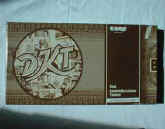 Edition:
DKT
- Das kaufmännische Talent Edition:
DKT
- Das kaufmännische Talent
Publisher: Stomo Spiele - Austria - ± 1950
Dimensions of the box: 26.0 x 50.4 x 4.4 cm
The game:
(The year of origin cannot be determined, but judging from the pictures it must
have been around 1950.)
This game is a called European because the Champs Elysees and the Rue
la Fayette stay brotherly next to Oxford Street and Piccadilly,
Kurfurstendamm and Potsdammerstrasse. In the midfield of the gameboard are drawn
impressions of the cities Hamburg, Paris, Bruxelles, Berlin, Zurich,
Wien and München. (In the Europe De Luxe version the cities Hamburg and Berlin
are replaced by Frankfurt and London).
Besides these streets there are also plants and public transport. On the Plants
and Public Transport spaces you pay freight charges.
On the 3 corners
spaces are resp.: violation of the law, 10% capital levy and arrest. (So the
Jail is at another corner).
The 15 Chance cards and 15 Bank cards are to be put on the
centrefield. The money consists of banknotes as well as round, hard
plastic coins. There are 6 tokens, 32 houses and 8 hotels.
Remarkable with this game is the Cone, a pawn that is to be placed
near one of the numbers 1 to 40 along side 1 of the board to count the number of
playrounds!
The rules are as well in French as in German.
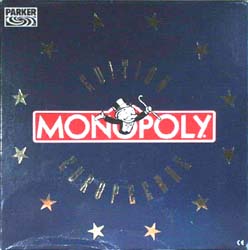 Edition:
European Edition - French Edition:
European Edition - French
Publisher: Parker/Tonka/Hasbro - 1991
Dimensions of the box: 27 x 27 x 8.4 cm
The game:
There is of course also a French version of this very nice issue! The very
carefully performed Rules to this edition says about theEiffeltower, the
French token:
"Gustave Eiffel himself called this easily recognizable construction his
300 m high flag pole. It is made of 12,500 pieces of crude iron and 2,500,000
rivets. The opinions about this construction, built in 1889 in honour of the
International Exhibition of 1890, were divided. It is said that Verlaine left
town to not been forced to see the Eiffeltower!
The other 11 tokens are:
Blarney Castle (Ireland), Brandenburger Tor (Germany), Abby of Clervaux
(Luxemburg), Atomium (Belgium), Parthenon (Greece), La Sagrada Familia (Spain),
Grundvig Church (Denmark), Leaning Tower of Pisa (Italy), Torre de Belem
(Portugal), Tower of London (England) and of course a windmill for The
Netherlands!
The properties are well-known streets in the joining countries, viz.:
 |
Denmark: Strandvejan - Slotsgade |
 |
Belgium: Louizalaan - Beenhouwersstraat - Grote Markt |
 |
The Netherlands: Coolsingel - Lange Poten - Kalverstraat |
 |
Spain: Paseo de la Castellana - Gran Vía -Las Ramblas |
 |
Greatt Britain: Oxford St. - Piccadilly - Park Lane |
 |
Italy: Via Veneto - Via Condotti - Via Monte-Napoleone |
 |
France: Avenue Foch - Avenue des Champs-Elysées - Rue de la Paix |
 |
Germany: Königsallee - Kurfürstendamm |
The 4 stations are replaced by airports of the countries:
Luxemburg - Portugal - Greece and Ireland.
In the period this game was launched on the market it was believed that the European
currency would become ECU! That is why there are 7 banknotes
with this game, all having the same illustration, in the denominations: 10
- 50 - 100
- 200 - 500
- 1000 and 5000
ECU. The back shows ECU in a black circle with 12 stars. Because
"investments are internationally done a large amount of money is
necessary" and that is why there is twice as much money with this issue. The banker's tray of this game is a
black plastic insert with 13 holes.
The backside of as well the Chance- as the Caisse de Communauté cards
are blue. In the stars circle is a ? at
Chance and at the Community Chest cards …. a Belgian ECU coin! The houses and
hotels are made of glossy wood and do have a roof edge. The dice
are blue and their pips are again stars of
course.
This set was made in "Waterford, Republic of Ireland".
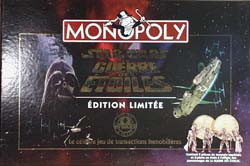 Edition: Star
Wars - La Guerre des Étoiles, Edition: Star
Wars - La Guerre des Étoiles,
Édition Limitée, Réf. 40786
Publisher: Parker Bros./Hasbro Inc. - 1996
Dimensions of the box: 25.7 x 51.0 x 5.3 cm
The game:
Indeed again a very beautifull edition with the stamp "Édition Limitée".
The cooperation between Parker Brothers and Lucasfilm Ltd. arose because of the 20th
anniversary of Star Wars! The so-called "limited edition" find
expression in the sticker on the gameboard showing both a date and a serial
number.
The most striking of this game is the 2 kinds of players (the Rebels
and Imperials) each having their own vehicles and locations!
The Rules are exactly equal to those of the regular game, the differences
however, are striking:
|
MONOPLY standard
|
|
STAR WARS MONOPOLY
|
|
6 to 10 tokens (hat, car, boat,
etc.)
|
|
8 tokens: 5 Rebels, 3 Imperials
|
|
streets with title deed cards
|
|
Galaxy properties with property cards
|
|
Income Tax and Luxury Tax
|
|
Docking tax and Bounty
|
|
Play money = French francs
|
|
Play money = Imperial Credits
|
|
-
|
|
5 brass coins of 1000 credits each
|
|
Green
houses + red hotels
|
|
2 sets of space vehicles
|
|
Chance and Caisse de Communauté cards
|
|
Imperial and Rebel cards
|
Each token is a well-known character from Star Wars. The Rebel
Alliance consists of Luke Skywalker, Princes Leia, Han
Solo, Chewbacca and R2-D2. The fighters for the Galactic Empire are
Darth Vader, Boba Fett and the Stormtrooper.
The vehicles used by the Rebels are
light grey X-wing Fighters
and Corellian Freighters and those of the Imperials are the dark
grey Tie Fighters and Star Destroyers.
The banknotes are in various colors with value-denotation at the right
side. The text with the illustrations is in Aurebesh!?
The bottom side of the box does not only contain a clear picture of the
gameboard and attributes, but also a good picture of the tokens: the
"Heroes" and "Villains"!
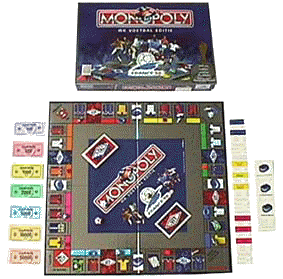 Edition: Edition
Football France 98,
Réf. 19618F Edition: Edition
Football France 98,
Réf. 19618F
Publisher: Parker/ Hasbro France S.A. - 1997
Dimensions of the box: 40 x 27 x 6.5 cm
The game:
This is a box in the colors dark blue, silver
and of course red.
The game board spaces can hardly be found on the cover, but so a couple of
soccer players, eachone in an energic posture but not in a match position! The
lid also contains a hologram sticker with logo France
98. On the bottom of the box is
again a clear picture of the game board and its attributes. Besides it shows
that an innerbox as soccer ground is supplied with the set!
The bankers tray is of soft dark blue
plastic and has a special space for the square game board. In this game
the properties are of course national soccer teams, viz. those of the 22
best clubs of the official worldlist as it is composed by the FIFA on the basis
of the results of the countries in all worldcup finals since 1930! On the
game board they are respectively: Scotland - Switserland - Romania - Chile -
Mexico - Belgium - Austria - Czechoslovakia - The Netherlands - Poland - Hungary
- Yugoslavia - France - Sweden - Uruguay - Russia - Spain - England -
Argentine - Italy - Germany and Brasil. The spaces have the well-known colored
bars and are furthermore characterized by a T-shirt of the concerning country!
The stations are replaced by the 4 most important stadiums of France,
viz. Stade Velodrome of Marseille, Stade Du Parc De Princes in Paris, Le Stade
De France in Saint-Denis and Stade De Gerland of Lyon.
The 2 public utilities are now Electric Works and Softdrink
Manufacturer (marked by a red beaker but
not of Coca Cola!). It is remarkable that one can be sent to Jail in this game
as well!
The Chance- and Caisse de Communauté spaces are here of course Domicile
(=Home) and Extérieur (=Away).
The 8 tokens are resp. a shoe, cap, beaker, hamburger (?), goal,
whistle, bal and the (gold colored) FIFA Worldcup Trophy (with the
mark "1974 FIFA TM© in the base).
Other differences with the standard MONOPOLY game are:
|
MONOPOLY
|
|
WC EDITION FOOTBALL
|
|
Income tax
|
|
Transfer costs
|
|
Green
houses and red hotels
|
|
Red
stands and blue stadiums
|
|
Sixsided dice
|
|
Football dice (all figures
double)
|
|
The money is Fr francs
|
|
The money has no value
|
The price of this set still amounted to Ffr 209.- (= US$ 33.-) in May 1999.
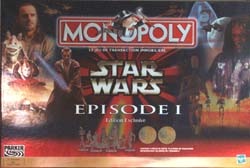 Edition:
Star Wars - Episode I, Réf. 40787101 Edition:
Star Wars - Episode I, Réf. 40787101
Édition exclusive
Publisher: Parker/Lucasfilm Ltd./Hasbro –
1999
Dimensions of the board: 26.8 x 40.0 x 6.5 cm
The game:
Authorities on this Galaxy event will recognize immediately
their heros and villains of the Trade
Federation on both the lid and the centre field of the gameboard! Of the 8
pewter tokens (with the mark "© LFL", of Lucasfilm)
the 4 heros are Anakin Skywalker, Jar Jar Binks, Qui-Gon Jinn and
Queen Amidala and the villains Darth Sidious, a Battle Droid, Darth Maul and
Sebulba.
There are no houses nor hotels built on the properties
that consist of 28 spaces of the Galaxy, but apartments and towers
instead. The apartments are structures of grey
plastic, while the towers are monumental buildings of goldbrown
plastic. The mortgage side of the property deeds is black.
The Chance- and Caisse de Communauté cards have
been replaced by respectively Jedi-
and Sith cards with
significant (?) texts like:
 |
The Jedi Council Fund expires - You receive # 100. |
 |
Your Galactic senatepension takes effect - You receive # 100. |
 |
Proceed to Otoh Gunga Gungan Sub – If you pass "Go" you
receive # 200. |
 |
Buy Droids for all your properties - Pay # 25 for each apartment and # 100
per tower. |
The currency of the Galactic money is Galactic
Credit. The banknotes are very simple, but there are 5 gold coins (value
# 100) as well, printed with "Galactic Republic". The Rules say about
them: "... for the collector! Should you wish so they can also be used for
larger amounts to pay!!
Both dice are of course black, with white pips. The practical
"bankerstray" is also of black plastic.
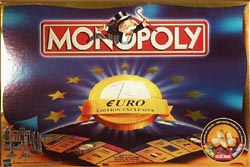 Edition:
Monopoly EURO, Réf. 05597 Edition:
Monopoly EURO, Réf. 05597
Publisher: Parker/Hasbro - 1999
Dimensions of the box: 27.0 x 40.2 x 6.5 cm
The game:
Of course Parker/ Hasbro took the
opportunity of the introduction of the Euro to issue a special edition again.
Was there in 1991 talk of but 12 countries of the European Community (see
the description of the game in the "blue
box"), now 15 countries belong to the European Union and 7
countries will join in the years to come. The makers of this game already
anticipated by situating these countries at the beginning of the game. The most
expensive properties are the capital cities of the countries who were
first to become member. Groups who became member together are partitioned to the
size of their capital population.
The capital cities and countries are from Départ on:
Vilnius (Lithuania) – Riga (Latvia) – Sofia (Bulgaria)
– Bukarest (Romania) – Warsaw (Poland) – Budapest (Hungaria)
– Genève (Switserland) – Helsinki (Finland) – Stockholm
(Sweden) – Vienna (Austria) – Lisbon (Portugal) – Madrid
(Spain) – Athens (Greece) – Dublin (Ireland) –Copenhagen
(Danmark) – London (United Kingdom) – Luxemburg (Luxemburg)
– Brussels (Belgium) – Amsterdam (The Netherlands) – Rome
(Italy) – Berlin (Germany) and Paris (France).
The 4 stations became the 4 busiest airports of Europe, namely
Schiphol (Amsterdam) – Rhein-Main (Frankfurt) – Paris Charles de Gaulle and
London Heathrow. Both utilities became: the European Parliament and the
European Court of Justice.
It is a pitty that there are but 8 tokens this time, a very limited
choice out of 22 countries! Seven of these tokens are the same as those of the
1991 edition. Only the Atomium from Belgium has been replaced by Manneke Pis!
And why are these pewter tokens not as nicely gilded? The carefully edited
booklet of the Rules give a detailed explanation of these tokens.
The 7 different banknotes are nice copies of the real €-notes. De € 1's
are gold and silver colored (plastic) coins. On or over Départ you receive € 200. There is no explanation given why the plastic houses with roof edge
and chimney are dark blue now and the hotels
gold brown. Both the dice are dark
blue with gold pips.
Worthy mentioning is the fact that the lid now shows a part of the
GO-space with a part of the first and fourth side in perspective. That is
remarkable because this same presentation is also applied by all City Games of
Winning Moves Int. who are issued in the UK, Germany and France since 1998! The bottom
of the box shows again a nice color picture of the gameboard with all its
attributes.
It is obvious to put the differences and similarities with the
European Edition of 1991 on a row:
|
Monopoly Euro
1999
|
Monopoly European Edition 1991
|
|
folded twice gameboard in a rectangular box
|
folded twice gameboard in square box
|
|
properties are capital cities of 22 countries
|
properties are groupes of 2 or 3 streets of 8
countries
|
|
"stations" are airports
|
"stations" are airports
|
|
in jail is .... Jack the Jailbird
|
in jail is …. nobody
|
|
the currency is Euro
|
the currency is Ecu
|
|
8 tokens of well-known buildings
|
12 tokens of well-known buildings
|
|
Mr.Monopoly in the red
bar
|
Oncle Riche in the red
bar
|
The catalog price of this set was Ffr 349 (= US$ 53.-) in August 1999.
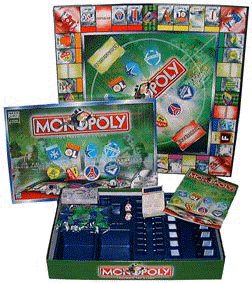 Edition:
Monopoly Football Top Clubs, Réf. 06041101 Edition:
Monopoly Football Top Clubs, Réf. 06041101
Publisher:Parker/Hasbro - Dec. 1999
Dimensions of the box: 27 x 40 x 6.5 cm
The game:
Unlike the soccer game of 1997 in this edition only French clubs are at
stake. Each of the 8 top clubs of which the lid and the centre field of
the gameboard show their logo has 2 or 3 spaces of one color being divided into:
1. Bureau du Conseil (Board of Directors)
2. Club house
3. Vestiaire (changing room)
From Départ on the properties are:
A.J Auxerre club house - A.J Auxerre vestiaire -
Indemnités de transfert -Tribune Sud -
Strasbourg Bureau du Conseil - Strasbourg club house - Strasbourg vestiaire -
En Prison - Girondins de Bordeaux Bureau du Conseil - Abonnement -
Girondins de Bordeaux club house - Girondins de Bordeaux vestiaire - Tribune
Ouest - R.c Lens Bureau du Conseil - R.c Lens club house - R.c Lens
vestiaire - Parc Gratuit - Paris Saint Germain Bureau du Conseil - Paris Saint Germain club
house - Paris Saint Germain vestiaire - Tribune Nord - Olympique
Lyonnais Bureau du Conseil - Olympique Lyonnais club house - Billetterie
(ticket sales) - Olympique Lyonnais vestiaire - Allez en Prison - Nantes
Bureau du Conseil - Nantes club house - Nantes vestiaire - Tribune Est -Olympique
de Marseille club house - Droits TV (TV rights) and Olympique de
Marseille vestiaire.
Of course the Chance- and Caisse de Communauté spaces are here
again Domicile
(Home) and Extérieur (Away). It is remarkable that even in
such a soccer game the 4 "holy corners" remain unchanged, so the same
as in the standard game!
The 8 tokens are resp. the Eiffeltower - a football - a whistle - a
referee - a goal - a football shoe -
a keeper and a field player. The nice banknotes show a football at
the right and football players at the left side. The banker's tray is
made of dark blue
plastic. The houses and hotels became resp. benches and stadiums.
Both dice are white with red
print and have the shape of a football.
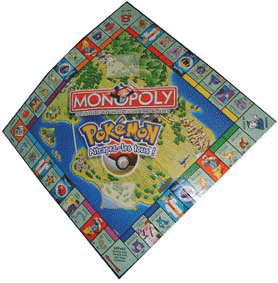 Edition: Monopoly Pokémon, Réf. 040041357101 Edition: Monopoly Pokémon, Réf. 040041357101
"Attrapez-les tous!"
Publisher:Parker/Hasbro/Nintendo
- 2000
Dimensions of the box: 26.9 x 40.3 x 6.7 cm
The game:
Of course the origin of this specialty edition is in America. However, because
Pokémon is a rage in France a French version is issued as well.
Easy to understand that there are no terms unknown for Pokémon freaks, however
for an uncomplicated Monopolist it looks interesting but names means
nothing to him. A grandson and authority of this phenomenon however, explained to me:
The World of Pokémon exsists of Gym's ("groups" with us) being
situated in 21 cities, forests, islands etc.. The board's midfield shows
this World almost completely.
(The computer game starts at Pallet Town (on the board close to the space #145
Zapdos). From there the play direction is via Viridian City - Viridian Forest - Pewter City - Mt.Moon Cerulean City
(unvisible under LY) - Sea Cottage (on the peninsula) - Rock Tunnel with
the Power Plant - Lavender Town (= the minaret on the T-crossing) - Diglett's
Cave (= the boulder under ALL!) to Fuchsia City and Safari Zone (mid under).
The island with pointed mountain is called Cinnaber Island and the other two
next to it Seafoam Island.)
The Gym's are managed by Trainers. Each Trainer has a preference for a
Pokémon type(with us the "streets"), versatile
intelligent creatures who basically don't like to be possessed. The Pokémon are
divided into15 types, identifiable by the vignette before the price. On the
gameboard was choosen for resp.: Boulder - Water - Electric - Grass - Psychic - Poison -
Fire and Earth. From Départ on the properties
are:
Brock's Gym: #74 Geodude - #95 Onix
Misty's Gym: #120 Staryu - #121 Starmie -
#116 Horsea
Lt. Surge's Gym: #100 Voltorb - #125
Electabuzz - #26 Raichu
Erika's Gym: #71 Victreebel - #114 Tangela -
#45 Vileplume
Sabrina's Gym: #64 Kadabra - #122 Mr. Mime -
#49 Venomoth
Koga's Gym: #109 Koffing - #89 Muk - #110
Weezing
Blaine's Gym: #58 Growlithe - #77 Ponyta -
#78 Rapidash
Giovanni's Gym: #31 Nidoqueen - #34 Nidoking
Instead of stations are 4 Poké-balls (by which Pokémon can
be catched!): Poké Ball
- Great Ball - Ultra Ball and Master Ball.
Professor Oak and Trainer Battle cards do replace the Chance and
Caisse de Communauté cards. The 6 tokens are well-known creatures of
this world, viz. #04 Charmander, #25 Pikachu, #35 Clefairy, #150
Mewtwo, #01 Bulbasaur and #09 Blastoise. They are packed extra
in a moulded holder of black plastic. The Poké-money consits
of 7 different banknotes the denominations of which are: 1 (white) - 5 -
10
- 20 - 50
- 100 100 and 500. Strangely enough the banker's tray has but 5 holes!
Instead of houses and hotels there are light blue,
square, stackable Poké Centers and red,
rectangular, non-stackable Poké Marts, all made of transparent plastic.
The dice are white with black pips.
To make this issue of Monopoly more like the Pokémon computer game
additional rules are added, the Pokémon Power Doubles. If you
through doubles, you may choose for to throw the dice again (as in the standard
game) or to use a Pokémon Power based on your doubles roll. It's value is given
in a chart in the Rules.
 Edition:
The Disney Themepark Edition, Ref.Nr. 40767 Edition:
The Disney Themepark Edition, Ref.Nr. 40767
Publisher: Parker/Hasbro Inc. - 2002
Dimensions of the tin: 26.5 x 26.5 x 8.5 cm
The game:
This edition is owned by David Miller - UK. He bought the tin in Magic
Kingdom Park, Florida - USA.
Since these parks are scattered over the world it is comprehensible the Instructions booklet
to be in English, Español and Français.
From Go onwards the spaces are:
Indiana Jones And The Temple Of Peril -
Magic Lamp- Star Tours -
Villain's Tax Pay 10% -
Disneyland Paris Train
- Orbitron
- Wishing Well - Space
Mountain - Pirates
of the Caribbean - Jail - Castle
Carrousel - Disney Wonder - Peter Pan's
Flight - Dumbo The Flying Elephant
- Tokyo Disneyland Boat - Jungle Cruise
- Magic Lamp - Big
Thunder Mountain Railroad
- Journey to the Center of the Earth
- Free Parking - Hollywood Tower Hotel
- Wishing WellKilimanjaro
Safaris - Spaceship Earth - Walt
Disney World Resort Bus - Buzz
Lightyear's Space Ranger Spin - Splash
Mountain - Disney Magic - The
Haunted Mansion - Go to Jail - Mr.
Toad's World Ride -
Mad Tea Party
- Magic Lamp - California
Screamin' - Disneyland
Resort Monorail - Wishing
Well - "It's a Small World" -Villain's
Tax
and Matterhorn.
The Chance cards became Magic Lamp cards, while the Community
Chest are here Wishing Well cards.
The denominations of the banknotes are in "Wishes".
The 8 tokens are Disney subjects like Tug Boat (Tug Boat
Willie) - Paddle Steamer (Tom Sawyer) - Train (Thunder
Mountain Railroad).
The set goes with 32 yellow
"Main Street, USA" buildings and 12 blue
"Disney Castles".
This edition was "Made in USA with bagged parts and tin made in China".
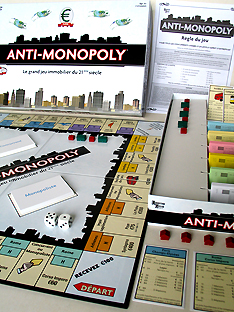 Edition: Anti-Monopoly®
- French edition, Ref. 08510 Edition: Anti-Monopoly®
- French edition, Ref. 08510
"Le
grand jeu immobilier du 21ème siècle"
Publisher:University Games Europe B.V.-NL - 2006
Dimensions of the box: 26.8 x 40.2 cm
The game:
On the bottom of the box is, next to a color picture of the game, a short explanation of the origin of the game and
how to play it.
The translation reads:
"An update of the "monopoly" folk game invented by Elizabeth Magie a 100 years ago.
The world-famous game based on our
capitalistic society where private
entrepreneurs struggle for profit.
The same applies for Anti-Monopoly®. Here players also fight to become the
richest real estate and landowner. To attain this
objective, players always
struggle for more power and eliminate their competitors merciless - not exactly
like in real life where
this is tried to prevent.
There competition looks after a functioning market with fair prices.
In Anti-Monopoly® players are divided into two
groups: competitors and monopolists. They follow
different rules as a result of
what the game becomes more dynamic and and richer
in variation."
Ralph Anspach is a Professor Emeritus of Economics
at San Francisco State University who invented this Anti-Monopoly game. He based
his creation on the monopoly folkgame which was invented by
Elizabeth Magie in 1904 and was played extensively in the Eastern United States
between 1904 and 1935. Players in the monopoly folkgame buy and trade properties
to monopolize color groupings.His game transforms the folk game into a battle
between competitors and monopolists and it retains the antimonopoly message of
the creators of monopoly. Quaker teachers (members of the Society of
Friends in Atlantic City, N.J.) transformed the folkgame into what is now played
as Monopoly.
Charles B. Darrow stole the knowledge of the game and its rules from these
Quakers, commercialized it, and falsely claimed that he had invented it to
get an invention patent. He licensed it to Parker Brothers which popularized the
legend of Darrow the Inventor.. .
Ralph Anspach discovered the truth about the history of Monopoly when he
became a defendant in a ten-year long law suit filed by Parker Brothers. He
eventually won that law suit, read his book "Monopolygate".
Anti-Monopoly®'s specialty is, as said, its principle
players have to choose between 2 play methods: that of the Monopolists
and the Competitors. However, which part you will prefer, all players
have equal chances to win, although they play according to different
Rules. So Monopolists for example, can only build houses and hotels when
they have a monopoly position in a town (what is the case
already when the
player owns 2 of 3 streets), while Competitors may build on each property,
independent of they own a whole city or one single street.
On the solid board with black back the streets of 8 cities
are from Départ onwards:
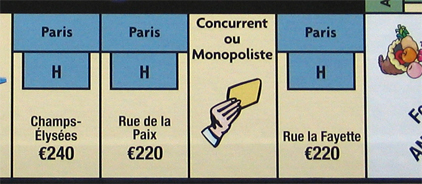 Rome: Corso Impero -
Concurrent ou Monopoliste - Via Roma - Impôts sur les revenu (Income
Tax) Rome: Corso Impero -
Concurrent ou Monopoliste - Via Roma - Impôts sur les revenu (Income
Tax)
Berlin: Alexanderplatz - Concurrent ou Monopoliste
-
Kurfürstendamm - Potsdammer Straße
Simple visite/Guerre des prix(price war)/Prison
(Jail)
Madrid: Plaza Mayor - Compagnie de
distribution d'électricité (Electric Comp.) - Gran Via - Paseo de
la
Castellana
Amsterdam: Dam - Concurrent ou Monopoliste
- Leidsestraat - Kalverstraat
Anti-Monopoly Stiftung (Anti-Monopoly foundation)
Paris: Rue
la Fayette -Concurrent ou Monopoliste - Rue de la Paix -
Champs-Élysées
Bruxelles:
Grand Place - Rue Haute - Société du Gaz (Gas company) -
Rue Neuve
Monopoliste: Allez en prison (Monopolist: Go to Jail) /
Concurrent: Rendez-vous à la Guerre des Prix (Competitor:
Go to the price war)
Londres:
Park Lane - Piccadilly -Concurrent ou Monopoliste - Oxford Street
Athènes:
Concurrent ou Monopoliste - La Plaka - Impôt supplémentaire (Special
tax) - Syntagma
The 4 spaces in the middle of each side are respectivily: l'Aéroport - Compagnie
de trams - Gare and Société de cars.
The 3 corner spaces clearly have different meaning for the Monopolists and the
Competitors.
Note that this gameboard has the same cities as the German and Dutch edition,
whereas that of the Baltic countries have replaced Berlin by their own capital
city and Finland even replaced Amsterdam and Madrid by two Finnish cities:
Helsinki and Turku.
The bottom part of the box contains a white cardboard insert foulded such
a way that a lower part between two platforms can be used as bankers' tray and
store for the houses and hotels.
There are no Chance- nor Community Chest cards in this game but 2x25
plain, white cards Monopoliste and Concurrent
instead, all with funny illustrations and always with detailed comment, like:
On the Concurrent cards:
 | Le gouvernement surveille de très près les entreprises qui transgressent
les lois anti-monopoles. Vous avez tout à y gagner!
CHAQUE MONOPOLISTE VOUS VERSE € 25. =
The Government closely see the Antitrust Laws to be obeyd. That is
to your advantage. COLLECT € 25 FROM EACH MONOPOLIST.
|
 | Vous démarrez une nouvelle entreprise. LANCEZ LES DÉS. 9 points ou moins
votre entreprise n'a décidément PAS D'AVENIR. 10 points
ou plus vous alleze faire un TABAC, LA BANQUE VOUS VERSE € 75. =
You are starting a new company. THROW THE DICE. If you
get a 9 or less IT FAILS. 10 or more: the company is successfully. THE
BANK PAYS YOU € 75.
|
 | Les monopolistes ont augmenté le prix des carburants. Vous en supportez
vous aussi les conséquences, mais la concurrence qui fait rage vous
empêche pratiquer cette augmentation des prix. Votre chiffre d'affaires est
en baisse. PAYEZ € 50 à la banque.=
The Monopolists have jacked up the price of gas.
Competition does not allow price increases. Your turnover falls. PAY the
bank € 50 . |
On the Monopoliste cards: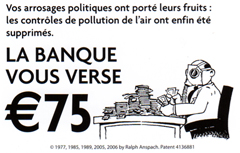
 | Vos arrosages politiques ont porté leurs fruits: les contrôles de
pollution de l'air ont enfin été supprimés.
LA BANQUE VOUS VERSE € 75. =
Your political contribution was not forgotten. The smoke pollution
controls, which cut down on your profits have
been abolished. THE BANK PAYS YOU € 75.
|
 | De mystérieuses magouilles vous ont permis d'emporter un contrat juteux.
Lancez les dés pour voir si vous conservez
votre contrat. 7 points ou moins ADIEU LE CONTRAT! 8 points ou plus ÇA
ROULE! LA BANQUE VOUS VERSE € 75.=
Through a shady deal, you landed a big contract. To see whether your deal will go through,
roll the dice. If you
get 7 or less NO DEAL, 8 or more IT SUCCEEDED! THE BANK PAYS YOU € 75.
|
 | Vous avez partiellement financé la campagne électorale d'un ministre et
- manque de bol - la presse en a eu vent.
PAYEZ € 50 à la banque. =
You made an illegal campaign contribution to a senator. The press got
wind of it. PAY THE BANK € 50. |
It is of course also necessary the two types of players to be taken into
account of on the property deeds. That is why they have 2 columns
for the prices: at the left for the Concurrent
and at the right side those for the Monopoliste.
The back side of the cards is also to show the property to be mortgaged. In this
situation the card must be given the bank, however, the owner can any
moment buy it back from the bank. This is also said on the back side of the
cards.
There are only 6 banknotes, printed in grey
on colored paper, in the denominations: 1
- 5 - 10
- 50 - 100
and 500. It is not clear why the Rules say
in bold "all banknotes have to be multiplied by 1000". This is of no importance for the course of the game!
There are only 6 plastic tokens, viz. of each a green
and blue one: cone, pyramid and a pawn like a "cilinder
with sphere".
The set goes with 35 houses and 15
hotels of plastic, with roof rim and chimney. (Note:
The Concurrents must place their houses and/or hotels on the name of the field, while the
Monopolistes must situate them on the "H"-spot.)
Both dice are white with black pips.
The first version of this 21st edition was published in 2005 in
the USA, soon followed by that of many European countries.
This edition was "Made in Spain".
The price of this edition was at the introduction € 19.95.
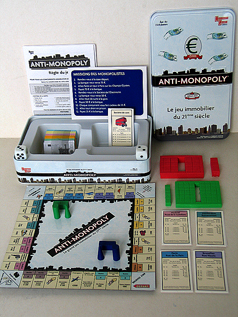 Edition: Anti-Monopoly® - Travel edition in a tin -
French edition, Ref. 08852 Edition: Anti-Monopoly® - Travel edition in a tin -
French edition, Ref. 08852
"Le
jeu immobilier du 21ème siècle"
Publisher:University Games Europe B.V.-NL - 2009
Dimensions of the tin: 11.5 x 19.2 cm
of the little board: 18.0 x 18.0 cm
The game:
It will not be too great a surprise that this travel edition is almost an exact
copy of that of the "long box". But there must of course
be
certain restrictions for this smaller version of the game, except for the tiny
game board and the nice tin with its insert of soft,
white plastic. Well, there
are, viz.:
 | The property deeds are smaller: 35 x 60 mm |
 | There are no Concurrent, nor Monopoliste cards,
but one small card with 11 instructions for both kind of players. And
this is the most drastic change, because all stories and funny
illustrations that go with the instructions disappeared. The blue
side of the card only very resticted instructions for the Monopolists, while
the dark green side shows what the
Wettbewerber
have to pay or do receive. |
 | The banknotes are miniatures (25x45 mm) of those
of the long box. |
 | The 6 smaller, wooden tokens are also in green
and blue, but now resp. a cone - beam
and cylinder. |
 | The 35 houses and 15
hotels (note that the colors has been
changed) are punched from a small block of foam plastic. |
 | The dice are those of the large edition. |
 | The Rules are on 4 pages of A6-size. |
This edition was "Made in China".
The price of this edition was at the introduction € 9.95.
|